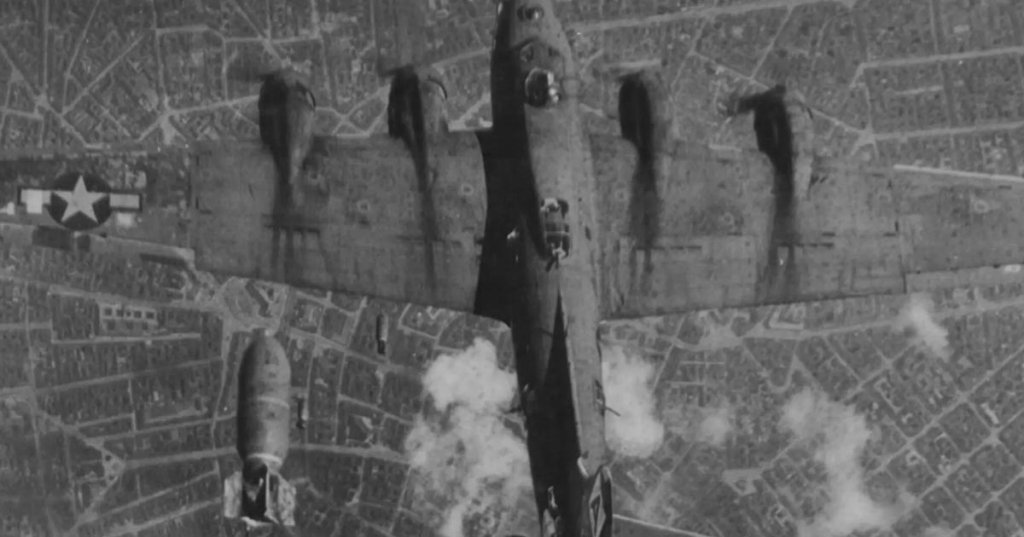
(National Archives)
Get We Are The Mighty’s Weekly Newsletter
Military culture and entertainment direct to your inbox with zero chance of a ‘Reply All’ incident
Bombing Europe in World War II was one of the most war’s dangerous jobs. Professor Thomas Childers of the University of Pennsylvania says being a British or American bomber pilot flying against Germany was the most dangerous role of the war, worse than submariner, merchant mariner, or infantryman.
It’s easy to see why, with B-17 and other bomb crews being forced to fly thousands of miles across flak-filled skies while being hunted by pursuit planes. For most of World War II, the bombers didn’t even have fighter support for the majority of their bombing runs. Once their escort fighters peeled away, the B-17’s best defense was to use their own machine guns to support one another in a box formation. But the box formation relied on each plane providing some cover to the planes above and ahead of them, meaning that bombers at the rear, low position in the formation were exposed.
German pilots quickly learned to attack from below and to hit the ball-turret gunner as quickly as possible. So, even within the B-17 bomber crew, there was a most dangerous role.
 U.S. B-17 bombers fly through clouds of flak. (Department of Defense) 23 B-17s, including Rose of York, were lost on February 3, 1945 (National WWII Museum)
U.S. B-17 bombers fly through clouds of flak. (Department of Defense) 23 B-17s, including Rose of York, were lost on February 3, 1945 (National WWII Museum)Bombing Berlin on May 19, 1944
It was against this backdrop that on May 19, 1944, bomb groups took off for another run to keep the pressure on Berlin. Even when bomb crews could fly straight to the target, Berlin was more than 500 miles from the nearest American airfields in England.
They knew that, for the duration of those 500 miles, they would have to weather flak, fire at attacking planes, and carefully monitor their own position within the formation. When it came time to drop their bombs, they had to add in the task of flying perfectly straight and level while the bombardier watched for the lead bomber’s falling ordnance and release their own payload on top of it.
In order to get the tightest bombing patterns, with as many bombs hitting as close together as possible, the lead B-17 bombers in a formation were high, and the rest of the bombers were stacked in a series that could stretch 900 feet down. When the first bomber dropped its bombs, each subsequent bombardier watched through their site for the lead bomber’s ordnance and then dropped the bomb the moment they saw it.
 A 1,000-pound bomb just before it hits the Miss Donna Mae II over Berlin in May 1944. (National Archives)
A 1,000-pound bomb just before it hits the Miss Donna Mae II over Berlin in May 1944. (National Archives) Ideally, that meant that bombs from each B-17 would pass in front of the noses of the rest of the bombers. That would result in all the bombs falling in a tight diamond shape on the target, maximizing target damage and limiting collateral.
 A 1,000-pound bomb knocks the left horizontal stabilizer off the Miss Donna Mae II, dooming the crew to crash in Berlin in May 1944. (National Archives)
A 1,000-pound bomb knocks the left horizontal stabilizer off the Miss Donna Mae II, dooming the crew to crash in Berlin in May 1944. (National Archives) What went wrong with the B-17 bombing mission?
But on May 19, at least one bomber drifted out of position. What is thought to have happened in these photos is that the pilot of the Miss Donna Mae II drifted forward just as the formation reached the target. That accidentally put the plane directly into the path of bombs falling from higher planes. Instead of the bombs falling ahead of the plane’s nose, one fell directly onto its left horizontal stabilizer.
 A 1,000-pound bomb knocks the left horizontal stabilizer off the Miss Donna Mae II. (National Archives)
A 1,000-pound bomb knocks the left horizontal stabilizer off the Miss Donna Mae II. (National Archives) The automatic camera on the higher B-17, named Trudy, captured the images. The Miss Donna Mae II almost makes it ahead of the falling bombs, which would have turned the accident into a miracle. But, instead, one of the bombs hits the stabilizer right on the root where it meets the plane’s tail.
 The B-17 Miss Donna Mae II crashes toward Berlin in May 1944. (National Archives)
The B-17 Miss Donna Mae II crashes toward Berlin in May 1944. (National Archives) The 1,000-pound bomb almost immediately knocked the stabilizer completely off, and the plane quickly entered a nosedive from which the pilot, First Lt. Marion Reed, could not save it. All 11 crew members sadly perished when the plane crashed into Berlin on Oderberger Street.
The four images of the final moments of Miss Donna Mae II and her crew stand as a reminder of the dangers a world war poses to all forced to take part in it.
Don’t Miss the Best of Mighty History
We Are The Mighty is a celebration of military service, with a mission to entertain, inform, and inspire those who serve and those who support them. We are made by and for current service members, veterans, spouses, family members, and civilians who want to be part of this community. Keep up with the best in military culture and entertainment: subscribe to the We Are The Mighty newsletter.
.png)



